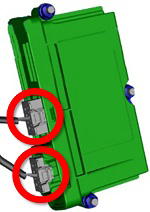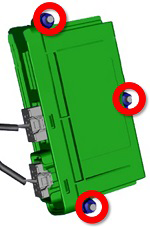Tesla Model S: Module - Sunroof Controller (RHD) (Remove and Replace)
Tesla Model S (2012-2025) Service Manual / Electrical / Module - Sunroof Controller (RHD) (Remove and Replace)
Warning: If the 12V power supply is disconnected, do not attempt to open any doors with door glass in closed position. Failure to follow this instruction could result in door glass shatter.
Note: Before disconnecting the 12V power supply, ensure that the driver's door window is fully open. Failure to follow this instruction could result in vehicle lockout.
Removal
- Move the passenger seat to its rearmost position.
- Disconnect 12V power.
- Rear wheel drive (RWD): Refer to procedure.
- Dual Motor: Refer to procedure.
- Remove the LH footwell cover (refer to procedure).
- Carefully peel back the front LH carpet for access. Caution: Take care not to damage component(s).
- Remove the bolts (x3) that secure the module cover panel.
- Disconnect the controller harness connectors (x2).

- Remove the nuts (x3) that secure the controller to the studs on
the bulkhead (torque 5 Nm).

- Remove the controller from the vehicle.
Installation procedure is the reverse of removal, except for the following:
-
Use Toolbox to update or redeploy the firmware:
- If the vehicle is not running the latest firmware, run the "Vehicle Firmware Update" procedure.
- If the vehicle is running the latest firmware, run the "Firmware Redeploy" procedure.
READ NEXT:
 Module - Air Suspension - ECU (Remove and Replace)
Module - Air Suspension - ECU (Remove and Replace)
Warning: If the 12V power supply is disconnected, do
not attempt to open any doors with door glass in closed position.
Failure to follow this instruction could result in door glass
shat
 Module - Air Suspension - ECU (Remove and Install)
Module - Air Suspension - ECU (Remove and Install)
Warning: If the 12V power supply is disconnected, do
not attempt to open any doors with door glass in closed position.
Failure to follow this instruction could result in door glass
shat
 Module - Air Suspension - ECU (RHD) (Remove and Replace)
Module - Air Suspension - ECU (RHD) (Remove and Replace)
Warning: If the 12V power supply is disconnected, do
not attempt to open any doors with door glass in closed position.
Failure to follow this instruction could result in door glass
shat
SEE MORE:
 Types of Airbags
Types of Airbags
Model S has the following types of airbags:
Front airbags: The front airbags are designed to
reduce injuries if larger children or adults are riding in
the front seats. Follow all warnings and instructions
related to seating a child on the front passenger seat
(if permitted in your m
 Charge rate reduced - Handle temperature high
Charge rate reduced - Handle temperature high
Check charge handle or charge port for debris
Charge current has been temporarily reduced because the Mobile Connector has
detected increased temperature in
the charge handle that connects to your vehicle's charge port.
Make sure the Mobile Connector is fully inserted into your vehicle's charge p
© 2019-2025 Copyright www.tesms.org

